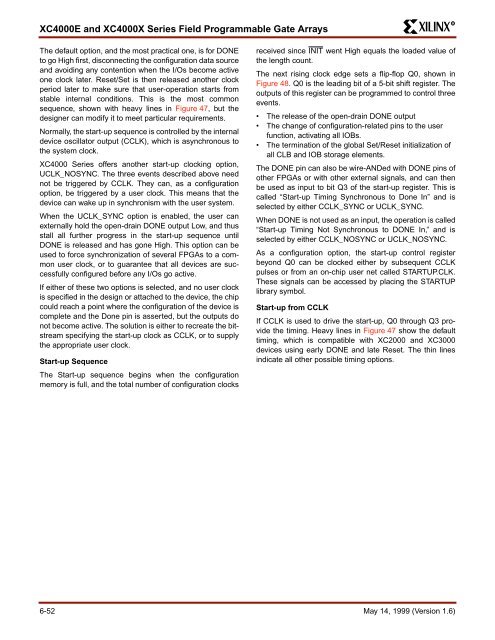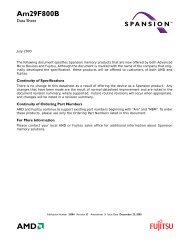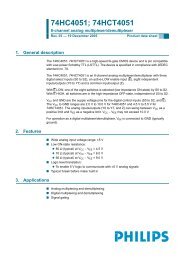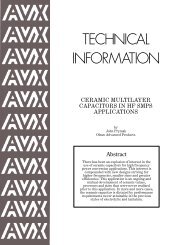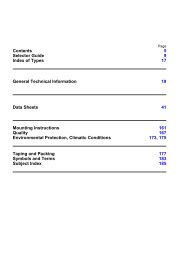Xilinx XC4000E and XC4000X Series FPGA data sheet functional ...
Xilinx XC4000E and XC4000X Series FPGA data sheet functional ...
Xilinx XC4000E and XC4000X Series FPGA data sheet functional ...
Create successful ePaper yourself
Turn your PDF publications into a flip-book with our unique Google optimized e-Paper software.
R<br />
<strong>XC4000E</strong> <strong>and</strong> <strong>XC4000X</strong> <strong>Series</strong> Field Programmable Gate Arrays<br />
The default option, <strong>and</strong> the most practical one, is for DONE<br />
to go High first, disconnecting the configuration <strong>data</strong> source<br />
<strong>and</strong> avoiding any contention when the I/Os become active<br />
one clock later. Reset/Set is then released another clock<br />
period later to make sure that user-operation starts from<br />
stable internal conditions. This is the most common<br />
sequence, shown with heavy lines in Figure 47, but the<br />
designer can modify it to meet particular requirements.<br />
Normally, the start-up sequence is controlled by the internal<br />
device oscillator output (CCLK), which is asynchronous to<br />
the system clock.<br />
XC4000 <strong>Series</strong> offers another start-up clocking option,<br />
UCLK_NOSYNC. The three events described above need<br />
not be triggered by CCLK. They can, as a configuration<br />
option, be triggered by a user clock. This means that the<br />
device can wake up in synchronism with the user system.<br />
When the UCLK_SYNC option is enabled, the user can<br />
externally hold the open-drain DONE output Low, <strong>and</strong> thus<br />
stall all further progress in the start-up sequence until<br />
DONE is released <strong>and</strong> has gone High. This option can be<br />
used to force synchronization of several <strong>FPGA</strong>s to a common<br />
user clock, or to guarantee that all devices are successfully<br />
configured before any I/Os go active.<br />
If either of these two options is selected, <strong>and</strong> no user clock<br />
is specified in the design or attached to the device, the chip<br />
could reach a point where the configuration of the device is<br />
complete <strong>and</strong> the Done pin is asserted, but the outputs do<br />
not become active. The solution is either to recreate the bitstream<br />
specifying the start-up clock as CCLK, or to supply<br />
the appropriate user clock.<br />
Start-up Sequence<br />
The Start-up sequence begins when the configuration<br />
memory is full, <strong>and</strong> the total number of configuration clocks<br />
received since INIT went High equals the loaded value of<br />
the length count.<br />
The next rising clock edge sets a flip-flop Q0, shown in<br />
Figure 48. Q0 is the leading bit of a 5-bit shift register. The<br />
outputs of this register can be programmed to control three<br />
events.<br />
• The release of the open-drain DONE output<br />
• The change of configuration-related pins to the user<br />
function, activating all IOBs.<br />
• The termination of the global Set/Reset initialization of<br />
all CLB <strong>and</strong> IOB storage elements.<br />
The DONE pin can also be wire-ANDed with DONE pins of<br />
other <strong>FPGA</strong>s or with other external signals, <strong>and</strong> can then<br />
be used as input to bit Q3 of the start-up register. This is<br />
called “Start-up Timing Synchronous to Done In” <strong>and</strong> is<br />
selected by either CCLK_SYNC or UCLK_SYNC.<br />
When DONE is not used as an input, the operation is called<br />
“Start-up Timing Not Synchronous to DONE In,” <strong>and</strong> is<br />
selected by either CCLK_NOSYNC or UCLK_NOSYNC.<br />
As a configuration option, the start-up control register<br />
beyond Q0 can be clocked either by subsequent CCLK<br />
pulses or from an on-chip user net called STARTUP.CLK.<br />
These signals can be accessed by placing the STARTUP<br />
library symbol.<br />
Start-up from CCLK<br />
If CCLK is used to drive the start-up, Q0 through Q3 provide<br />
the timing. Heavy lines in Figure 47 show the default<br />
timing, which is compatible with XC2000 <strong>and</strong> XC3000<br />
devices using early DONE <strong>and</strong> late Reset. The thin lines<br />
indicate all other possible timing options.<br />
6-52 May 14, 1999 (Version 1.6)


